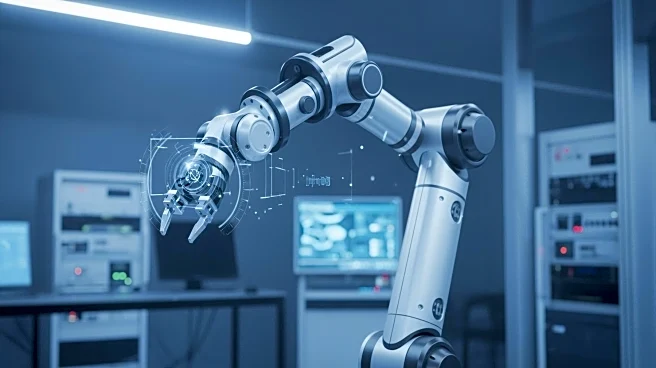What's Happening?
Researchers have developed a gaze-controlled robotic arm that utilizes augmented reality (AR) and object detection to assist individuals with severe motor impairments. The system, detailed in the journal
Scientific Reports, integrates the Microsoft HoloLens 2 headset for spatial mapping and eye tracking, allowing users to control the robotic arm through an intuitive interface. The technology eliminates the need for physical input devices, such as joysticks, which are often challenging for users with motor impairments. The system employs a lightweight YOLOv8n model for real-time object detection, identifying items like cups or bottles and overlaying bounding boxes in the user's view. Users can select objects by focusing on them for five seconds, after which the system calculates the object's 3D position and plans the robotic arm's path for grasping. The study involved four participants and demonstrated a 100% success rate in object grasping within a one-meter range, though performance declined beyond this due to depth perception limits.
Why It's Important?
This development is significant as it offers a practical and user-friendly alternative to traditional assistive technologies, potentially enhancing the independence of individuals with severe motor impairments. By integrating AR and gaze-based controls, the system provides a hands-free solution that could improve the quality of life for users who struggle with conventional input devices. The technology's ability to accurately detect and interact with real-world objects in 3D space marks a substantial advancement in assistive robotics, offering a competitive edge over previous systems. The success of this system within its optimal operating range highlights its potential for widespread application, though further refinement in depth accuracy is needed to extend its capabilities. This innovation could lead to broader adoption of AR-based assistive technologies, influencing both healthcare and technology sectors.
What's Next?
Future research will focus on improving the system's depth accuracy to extend its effective range beyond one meter. The authors suggest that larger studies are necessary to validate the generalizability of the results, potentially involving more participants to ensure consistent performance across diverse user groups. Enhancements in AR-based depth estimation could further refine the system's capabilities, making it more versatile for various tasks. As the technology evolves, it may attract interest from healthcare providers and tech companies looking to integrate advanced assistive solutions into their offerings. Continued development could lead to new applications in rehabilitation and daily living aids, expanding the impact of AR and robotics in assistive technology.
Beyond the Headlines
The integration of AR and gaze-based controls in assistive technology raises ethical considerations regarding accessibility and user privacy. Ensuring that such systems are affordable and widely available is crucial for equitable access. Additionally, the reliance on eye-tracking technology necessitates robust privacy protections to safeguard user data. As the technology advances, it may also influence cultural perceptions of disability, promoting greater acceptance and integration of assistive devices in everyday life. Long-term, this innovation could drive shifts in healthcare policy, emphasizing the importance of technology in enhancing patient autonomy and quality of life.













